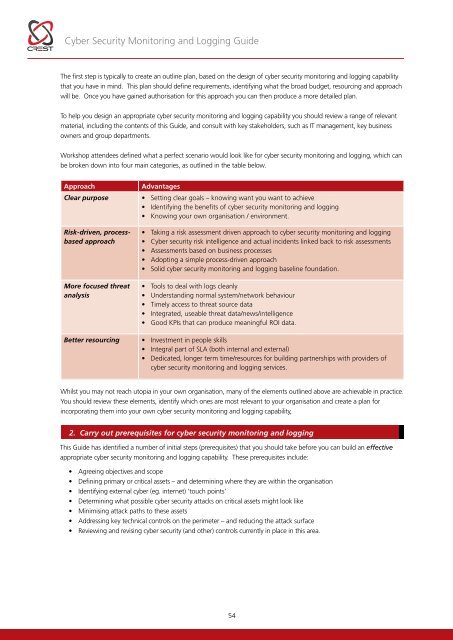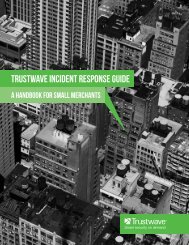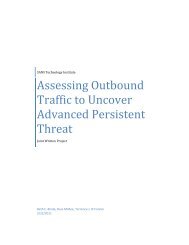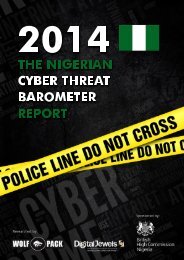Cyber-Security-Monitoring-Guide
Cyber-Security-Monitoring-Guide
Cyber-Security-Monitoring-Guide
Create successful ePaper yourself
Turn your PDF publications into a flip-book with our unique Google optimized e-Paper software.
<strong>Cyber</strong> <strong>Security</strong> <strong>Monitoring</strong> and Logging <strong>Guide</strong>The first step is typically to create an outline plan, based on the design of cyber security monitoring and logging capabilitythat you have in mind. This plan should define requirements, identifying what the broad budget, resourcing and approachwill be. Once you have gained authorisation for this approach you can then produce a more detailed plan.To help you design an appropriate cyber security monitoring and logging capability you should review a range of relevantmaterial, including the contents of this <strong>Guide</strong>, and consult with key stakeholders, such as IT management, key businessowners and group departments.Workshop attendees defined what a perfect scenario would look like for cyber security monitoring and logging, which canbe broken down into four main categories, as outlined in the table below.ApproachClear purposeRisk-driven, processbasedapproachMore focused threatanalysisBetter resourcingAdvantages• Setting clear goals – knowing want you want to achieve• Identifying the benefits of cyber security monitoring and logging• Knowing your own organisation / environment.• Taking a risk assessment driven approach to cyber security monitoring and logging• <strong>Cyber</strong> security risk intelligence and actual incidents linked back to risk assessments• Assessments based on business processes• Adopting a simple process-driven approach• Solid cyber security monitoring and logging baseline foundation.• Tools to deal with logs cleanly• Understanding normal system/network behaviour• Timely access to threat source data• Integrated, useable threat data/news/intelligence• Good KPIs that can produce meaningful ROI data.• Investment in people skills• Integral part of SLA (both internal and external)• Dedicated, longer term time/resources for building partnerships with providers ofcyber security monitoring and logging services.Whilst you may not reach utopia in your own organisation, many of the elements outlined above are achievable in practice.You should review these elements, identify which ones are most relevant to your organisation and create a plan forincorporating them into your own cyber security monitoring and logging capability,2. Carry out prerequisites for cyber security monitoring and loggingThis <strong>Guide</strong> has identified a number of initial steps (prerequisites) that you should take before you can build an effectiveappropriate cyber security monitoring and logging capability. These prerequisites include:• Agreeing objectives and scope• Defining primary or critical assets – and determining where they are within the organisation• Identifying external cyber (eg. internet) ‘touch points’• Determining what possible cyber security attacks on critical assets might look like• Minimising attack paths to these assets• Addressing key technical controls on the perimeter – and reducing the attack surface• Reviewing and revising cyber security (and other) controls currently in place in this area.54










